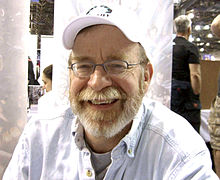Walt Simonson
Walter "Walt" Simonson (born September 2, 1946 ) is an American comic book author and illustrator.
life and work
After studying geology at Amherst College, Simonson began training as an academic draftsman at the Rhode Island School of Design in the late 1960s. His thesis (1973), the black and white space story "The Star Slammers", was rated so successful that it was used as a commercial by the organizers of the World Science Fiction Convention in Washington DC. Simonson later took up the theme and scenario of Star Slammers twice: once in a graphic novel published by Epic Comics and in the 1990s in one first for Malibu Comics (parts 1–4) and then for Dark Horse Comics (part 5) published miniseries. In the same year Simonson received the renowned Shazam Award in the category “Best New Artist”.
In the further course of the 1970s Simonson worked on the one hand as an illustrator for the book publisher Harry N. Abrams, for which he illustrated an edition of Tolkien's fantasy novel The Hobbit , on the other hand as a draftsman for the major American comic publishers DC Comics and Marvel Comics . At DC Simonson initially created war stories. He finally experienced his artistic breakthrough with the series “Manhunter”, which received three Shazam prizes in the “Best Short Story” category, which combined a traditional subject of crime fiction - the agent on a secret mission - with motifs from Far Eastern martial arts and philosophy. The Manhunter stories that Simonson drew and co-authored with the author Archie Goodwin were initially published as a backup series in the Detective Comics series, but later saw numerous reprints in the form of bound anthologies.
Other work that Simonson delivered for DC in the 1970s included drawings for the Metal Men series and for some of Steve Englehart's Batman stories in the Detective Comics series .
After Simonson took on the comic book adaptation of Ridley Scott's sci-fi classic Alien in 1979 - again in collaboration with Goodwin - he switched to Marvel Comics in the early 1980s. There he put in the 1980s well-known stories for the series The Mighty Thor and X-Factor , which are still considered the highlights of the respective series. His future wife, Louise Simonson , was sometimes the artistic partner . The stories for Thor and X-Factor represent a decisive turn in his artistic creative process, especially because Simonson appeared there for the first time on a regular basis as the author of the stories he visualized.
In the 1990s, work on the Marvel series Fantastic Four followed . From 2000 to 2002, Simonson was in charge of the science fiction series Orion, which was published by DC and based on the cosmos of the Fourth World mythology developed by Simonson's great artistic role model Jack Kirby , the monumental attempt to create a complete mythological system based on the model of the naturally grown Greco-Roman or to artificially recreate the Norse mythology.
This was followed by work on the series Wonder Woman (2003) and Hawkgirl (2006). His artistic partners were the cartoonists Jerry Ordway and Howard Chaykin .
In 2002 Simonson and Will Eisner , Mike Mignola and others published the book Panel Discussions , a non-fiction book with instructions for the graphic imitation of movement processes in comics and animation.
Web links
- Lambiek: Walter Simonson (English)
- German-language publications in the ComicGuide
Individual evidence
- ↑ comics.org: Marvel Graphic Novel 6
- ↑ comics.org: Malibu Series
- ↑ comics.org: Dark Horse Special
- ↑ For the first time in 1984, see comics.org: Manhunter
- ↑ From issue 45, see comics.org
- ↑ From issue 337, see comics.org
- ↑ From issue 10, see comics.org
- ↑ From issue 334, see comics.org
| personal data | |
|---|---|
| SURNAME | Simonson, Walt |
| ALTERNATIVE NAMES | Simonson, Walter (full name) |
| BRIEF DESCRIPTION | American comic book writer and illustrator |
| DATE OF BIRTH | September 2, 1946 |
